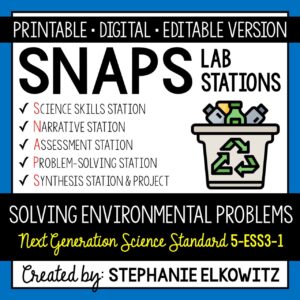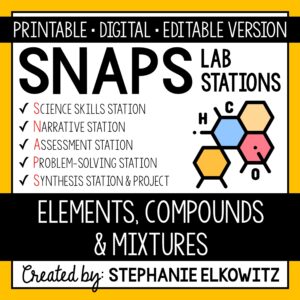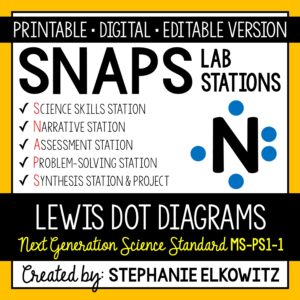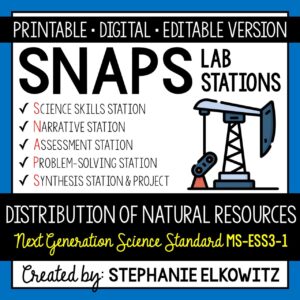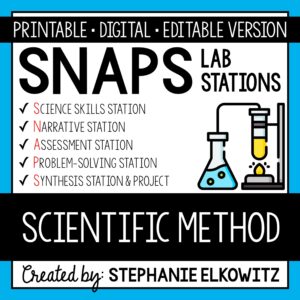5-PS1-4 Physical vs. Chemical Change Lab
$7.00
An engaging lab activity designed to enhance students’ ability to discern between physical and chemical change. Aligned with NGSS 5-PS1-4.
Description
5-PS1-4 Physical vs. Chemical Change Lab Preview
SNAPs Lab Stations Activities require students to use science, math, literacy, problem-solving and engineering skills. They are designed to enhance students’ understanding of scientific concepts and help students apply scientific ideas to the real world. Each station activity promotes skills so to develop students into proficient and competent scientific thinkers.
SNAPs lab activities have five components:
• Science Skills Station to develop science skill proficiency
• Narrative Station to build science literacy
• Assessment Station to evaluate learning and understanding
• Problem-Solving Station to foster engineering design
• Synthesis Station and Project to inspire higher-order learning
DIGITAL LABORATORY – DISTANCE LEARNING & DIGITAL CLASSROOMS
• This lab is offered in a digital format to support digital classrooms & distance learning.
• The digital lab activity is designed to work with Google Slides and Microsoft PowerPoint
• The digital lab activity CANNOT be edited. However:
– Students can manipulate text boxes
– Students can create tables, graphs and diagrams
– Students can insert images and drawings
GOOGLE FORM ASSESSMENT STATION
• The assessment station is offered as a self-grading Google Form.
• Questions are all short answer and are 100% editable.
• Suggestions for use are included in the download.
DISTANCE LEARNING COMPATIBILITY
SNAPs lab activities are rated for their ease with distance – independent learning. Refer to the preview for more information about how well this laboratory works in a fully digital classroom and with distance learning.
EDITABLE DOCUMENTS
This download includes an editable word document (docx file) of all lab components:
• Pre-Lab and Post-Lab Activities
• The Lab Overview
• Lab Station Activities and Questions
• Directed Synthesis Project (when applicable)
Important Notes:
• Diagrams, illustrations, tables and graphs essential to lab activities are included
• Illustrative clipart is NOT included
• Editable documents and rubrics are included with the FREE SNAPs Setup Guide
Editable files allow you to:
• Edit the scope of the activities so to suit your students’ needs
• Edit the materials required based on resource availability
• Create single-period “mini-labs” using activities at the individual skills stations
The activities at each station in this lab are detailed below.
Physical vs. Chemical Change Lab Stations Activity Learning Objectives
1. Compare and contrast a physical and chemical change.
2. Make observations of a physical and chemical change.
3. Carry out and evaluate a design for homemade slime.
Science Skills Station
Students will conduct an investigation that determines whether the mixing of two substances results in a new substance. Specifically, students will mix distilled white vinegar with different substances, make observations and determine whether a physical or chemical change occurred.
Narrative Station
Students will read an informational text about physical and chemical change. Students will also complete a sorting activity that requires students to categorize examples of physical and chemical changes.
Assessment Station
At this station, students will answer questions about key terms and ideas relating to physical and chemical change. Students must employ lower, mid and higher order thinking skills to answer these questions.
Problem-Solving Station
Students will make slime at this station. They will evaluate the “slime design” as to how well it behaves like both a solid and liquid and suggest improvements to the design so to improve its function.
Synthesis Station
Students will compose a CER (claim-evidence-reasoning) report to summarize the lab. Students are provided the claim statement and must support the claim with observations, data and other information gathered in the lab. Students will explain how the evidence supports the claim using scientific reasoning.
Synthesis Project
Students will have a choice of 11 projects. Refer to the SNAPs Lab Stations Best Practices and Setup Guide for directions and suggestions on how to conduct the project.
This download includes:
• A pre-lab assignment and post-lab reflection
• Directions and questions for each lab station
• Student recording sheets
• Teacher Key
Additional Materials Required:
Distilled Vinegar
Water
Milk (any kind)
Dish soap
Baking soda
Salt
Borax
Elmer’s Glue
Graduated cylinder
Teaspoon measuring device
2 ¼ cup measuring devices
1 ½ teaspoon measuring device
Cups or beakers (5 per group)
Plastic bowls (2 per group)
Plastic spoons (7 per group)
Sandwich Ziploc Bag (1 per group)
Spray and paper towels (for cleanup)
Rubber gloves (1 pair per student)
NEXT GENERATION SCIENCE STANDARDS
This laboratory satisfies NGSS 5-PS1-4. It combines the three dimensions of science learning – science and engineering practices, disciplinary core ideas and crosscutting concepts – to meet the standard. This lab also makes interdisciplinary connections to STEM, Math CCSS and ELA CCSS to build the appropriate skills.
TERMS OF USE
• All rights reserved by Stephanie Elkowitz.
• This product is to be used by the original purchaser only.
• Intended for classroom and personal use only.
• Copying for more than one teacher, classroom, department, school, or school system is prohibited.
• This product may not be distributed or displayed digitally for public view.
• Failure to comply is a copyright infringement and a violation of the Digital Millennium Copyright Act (DMCA).





